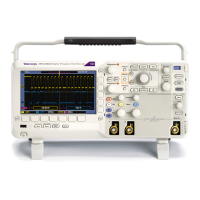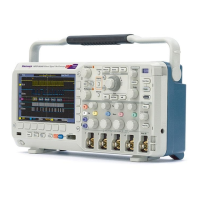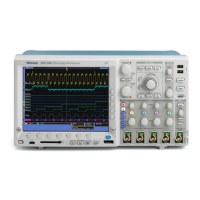Commands Listed in Alphabetical Order
SELect:REF<x
>
Turns on and off the display of the reference waveform <x>. The <x > variable
represents the reference c hannel number. The query returns whether the channel
is on or off.
Group
Vertical
Syntax
SELect:REF<x> {ON|OFF|<NR1>}
SELect:REF<x>?
Arguments
ON turns on the display of the specified waveform. This w
aveform also becomes
the selected waveform.
OFF turns o ff the display of the specified waveform.
<NR1> = 0 turns off the display of the specified waveform; any other value turns
on the display of the specified waveform.
Examples
SELECT:REF2 ON turns the channel 2 waveform display on, and selects reference
waveform 2.
SELECT:REF2? might return :SELECT: REF2 1 indicating that reference
waveform 2 is being displayed.
SET? (Qu
ery Only)
Returns the commands that list the oscilloscope settings except for configuration
information for the c alibration values, the WFMInpre? query, and the
WFMOut
pre? query. This query allows you to record or "learn" the current
oscilloscope settings. You can use these commands to return the oscilloscope to
the state it was in when you made the SET? query. The SET? query always returns
command headers, regardless o f the setting of the HEADer command. This is
because the returned commands are intended to be sent back to the oscilloscope as
a command string. The VERBose command can still be used to specify whether
the r
eturned headers should be abbreviated or full-length.
This command is identical to the *LRN? command.
Group
Miscellaneous
Syntax
SET?
2-288 MSO2000B, DPO2000B, M SO2000 and DPO2000 Series Oscilloscopes Programmer Manual

